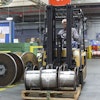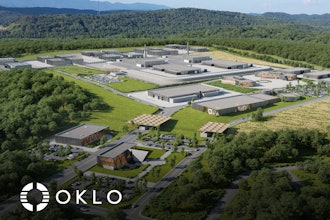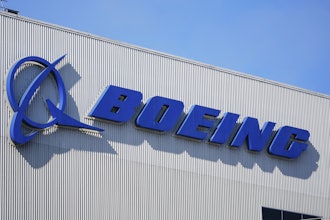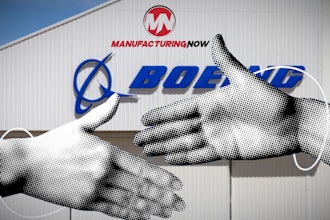May 2013, IDC Manufacturing Insights #IDCWP13V
Get Customers Inspired: How Modern ERP
Can Support Greater Customer
Experience
W H I T E P A P E R
Sponsored by: Epicor
Pierf rancesco Manent i Lorenzo Verones i
May 2013
E X E C UTI VE SUMMA RY
IDC Manufacturing Insights recently conducted a worldwide study of
over 460 enterprises across multiple sectors including industrial
machinery and equipment, high-tech and metal fabrication, and
covering 13 countries worldwide. The survey showed that:
● The business focus of worldwide manufacturing companies
currently continues around costs and profitability, which our
results show is more of a concern for companies in developed
countries. Looking forward, however, business initiatives are
customer-orientated. The shift toward value-added services has
been evident for a few years, but what is new is the importance of
improving customer experience. Companies in all countries and
industries covered in this survey will be concentrating on serving
their customers better, but they still need to understand better how
this can overcome cost challenges and ultimately grow their
businesses.
● The research reveals an immaturity about the definition of
customer experience which ultimately impacts how a customer-
oriented strategy manifests itself inside the organisation.
Companies continue to describe good customer experience in
terms of products or service features and functions and their
alignment to the customer's needs. Only 9% of leading companies
have fully realised the importance of creating a customer-oriented
culture and process workflows to generate superior customer
experience.
● The role of ERP appears crucial to improving customer experience.
Companies on higher levels in the customer experience maturity
model have a higher consideration of their ERP as a key tool in
delivering a good customer experience. This is more evident in
larger organisations that combine a single instance ERP with a
customer-centric culture, but smaller and midsized companies
could also see the same benefits by replicating this model. The
research indicates that an improved customer experience can be
gained through investments in modern, fully integrated, flexible
and easy to use ERP systems that streamline all operational
G
lo
ba
l H
ea
dq
ua
rte
rs
: 5
S
pe
en
S
tre
et
F
ra
m
in
gh
am
, M
A
0
17
01
U
S
A
P
.5
08
.9
88
.7
90
0
F.
50
8.
98
8.
78
81
w
w
w
.m
an
uf
ac
tu
rin
g-
in
si
gh
ts
.c
om
Page 2 #IDCWP13V ©2013 IDC Manufacturing Insights
processes and connect back office with front office by offering
integrated CRM, warranty and aftermarket functionalities.
Over the next three years, manufacturers will have to consider
prioritising initiatives aimed at improving the customer experience.
They will have to build customer-centric values into purchasing
decisions to reduce the current emphasis on costs. Partnering with
suppliers will also be beneficial to deliver customer experience. Last
but not least, manufacturers will have to rely on the critical support of
modern IT. An open and modern ERP will be an essential tool to
improve customer experience, but to become truly customer-centric
they will have to combine technology and processes with an embedded
customer-oriented culture at all levels of the organisation.
S I T UA TI ON OVE R VI E W
The global manufacturing industry is passing through what is probably
one of the most complex market contexts ever. In recent years, the
business landscape has been dominated by a sequence of financial
crises and by a continued threat of instability in global markets. The
impact of this tough economic situation has been very relevant to the
manufacturing industry, which has seen profitability challenged by a
number of factors, including the need to retain clients and the struggle
to expand into new markets.
This dramatic change in the marketplace clearly emerges from our
research as the most compelling concern for manufacturers worldwide.
This is translated into a challenging worldwide competition and the
need to keep operational cost and profitability under control. Other
than these obvious and understandable concerns, what is very notable
in our survey results is the challenge for manufacturers to retain
existing clients. Customer retention is among the most challenging
concerns for manufacturers, particularly in developed economies
where it is viewed as one of the most critical challenges together with
profitability.
Companies in developed markets feel the pressure of aggressive
competition that is eroding their market. Their existing customer base
— pressured themselves by the need to keep costs under control — is
eagerly looking at emerging competitors as a viable alternative.
Manufacturers located in emerging geographies have instead different
immediate challenges, notably the need for business growth. Thus
their aggressive competitive approach to expand in worldwide markets
by leveraging their lower production costs.
Although operational costs continue to be one of the manufacturing
industry's biggest concerns, it is not directly translated into cost cutting
initiatives as was evident in the past few years. After years of crisis,
manufacturers understand that a business strategy purely based on cost
cutting isn't sustainable. The top business initiatives emerging from
our survey (Figure 1) show that the future focus is about growth and
differentiation through value-added services and improved customer
experience.
©2013 IDC Manufacturing Insights #IDCWP13V Page 3
The shift toward value-added services has been evident for a while, but
the importance of improving the customer experience is now
appearing as significant. Traditionally, manufacturers have been more
focused on their engineered products or the efficiency of their assets
rather than on the satisfaction of their clients. This traditional inward
looking approach is now giving way to a more modern outward
looking, customer-driven approach.
F I G U R E 1
K e y B u s i n e s s I n i t i a t i v e s
Q. What business initiatives do you expect your company will undertake over the next three
years?
Number of valid respondents: 465
Base: All Sample
Source: IDC Manufacturing Insights, 2013
T HE A P PR OACH
There are several possible definitions of customer experience. One that
is common and well accepted says customer experience is defined as
"the sum of all experiences a customer has with a supplier of goods
and services, over the duration of the relationship with that supplier".
Customer experience is therefore built on all the interactions a
manufacturer has with a supplier. If those interactions have been
effective, if it has been easy to do business with that supplier and, most
importantly, if the level of satisfaction is superior to other similar
suppliers, then the purchaser will certainly buy again. However, in a
competitive marketplace, if the experience is not fully positive, the
purchaser will search for an alternative provider. The time of loyal
1 2 3 4 5
Implement lean/six sigma or other continuous
improvement initiatives
Better collaborate with suppliers
Cut costs
Increase productivity
Better align IT with the business
Foster product and service innovation
Improve sales force ef fectiveness
Improve customer experience
Optimise supply chain and production processes
Sell added-value services on products
Expand in emerging markets
(Average)
Page 4 #IDCWP13V ©2013 IDC Manufacturing Insights
customers has passed unless they are supported by appropriate
initiatives aimed at creating a superior customer experience.
This holds particularly true in today's marketplace often characterised
by fast product commoditisation and where new customers are gained
with price discounts. There is no winner in a competitive battle based
on mere price cutting and discounts. To stand out from competition it
is essential to find a way to leave the endless loop of price erosion.
Delivering a superior customer experience plays a vital role in creating
value. Value can counterbalance shrinking prices.
There are several factors that contribute to building a good customer
experience. The foundational elements are of course related to the
basics of customer-supplier relations: meeting customer expectations
in terms of features, quality and price.
However, in a modern business environment, customer experience is
much more than that. It is related to the service level the supplier is
able to provide to its customer, beyond the manufactured product
itself. It includes, for example, the ability to deliver the perfect order –
right quality, quantity, location, and due date — and the range of
aftermarket services supporting the initial product. An enhanced
customer experience paves the way for customer loyalty and longer
lasting relationships between supplier and purchasers.
Beyond aftermarket services, customer experience encompasses a
number of essential capabilities including how easy an organisation is
to do business with, reliability, speed of interaction, and willingness to
help or serve. These capabilities create an essential engagement to the
product, service, company or brand, and create business benefits
including differentiation from competitors, profit increase, and
business growth. And this is the ultimate goal for any manufacturer.
L a c k o f C u s t o m e r E x p e r i e n c e M a t u r i t y
Though improving customer experience is among the top business
initiatives for many manufacturers worldwide, its definition, its level
of maturity, and approaches toward improving it greatly differ across
manufacturers.
Data shown in Figure 2 highlights that customer retention,
differentiation from competitors and sales force effectiveness are the
top three perceived benefits of delivering a good customer experience.
Those capabilities are essential elements of a greater customer
experience and can go a long way toward stabilising revenues. Our
respondents, however, have not wholly grasped that delivering a good
customer experience can positively impact profitability, revenue
growth and the attraction of new clients.
©2013 IDC Manufacturing Insights #IDCWP13V Page 5
F I G U R E 2
C u s t o m e r E x p e r i e n c e B e n e f i t s
Q. What are the main benefits of creating a greater customer experience?
Number of valid respondents: 465
Base: All Sample
Source: IDC Manufacturing Insights, 2013
This lack of customer experience maturity is further demonstrated in
Figure 3. This tells us that when interacting with suppliers, the key
factor negatively impacting the experience is price. Although price is
an essential element of a happy supplier-customer transaction, it
doesn't represent what customer experience really is.
In today's manufacturers' mindset, price still supersedes in importance
even elements such as concerns on supply reliability, quality and lead
time. This shows how purchasing is very much being squeezed by the
continuing need to reduce costs and increase profitability.
It is our impression that the majority of respondents to our survey are
still prone to a crisis-minded approach to the marketplace, where lower
prices and discounts are seen as the only way to go to market. This is a
very short-term strategy that can't last very long. It negatively affects
profits, it doesn't sustain differentiation and it doesn't create any long-
lasting business growth.
Given quality and price are increasingly commoditised features in
today's marketplace, competitive differentiation needs to be found
somewhere else. Research results presented so far suggest that to build
long lasting competitive advantage, manufacturers have to realise that
there is much more they have to do other than just meeting price
0 10 20 30 40 50 60 70 80
Attract new clients
Higher prof its
Revenue growth
Support expansion in emerging market
Reduce costs
Improve sales force ef fectiveness
Dif ferentiate f rom competition
Retain existing clients
(%)
Page 6 #IDCWP13V ©2013 IDC Manufacturing Insights
expectation. And as customer experience is cited here as a top business
initiative, over the next three years manufacturers will have to build
service quality and customer-centric values into their purchasing
decisions.
F I G U R E 3
F a c t o r s N e g a t i v e l y I m p a c t i n g t h e C u s t o m e r E x p e r i e n c e
Q. When interacting with your suppliers, what are the key factors that you feel negatively
impact your experience?
Source: IDC Manufacturing Insights, 2013
P u r c h a s e r s a r e F r o m M a r s a n d S e l l e r s a r e
F r o m V e n u s
The roots of this immature view of customer experience can be found
by measuring the current level of customer experience along the value
chain. One of the most striking survey results is the significant
difference between the experience manufacturers believe they provide
to their customers and the experience the customers get when working
with their suppliers.
Figure 4 shows that as purchasers they are not fully happy with the
overall experience with their suppliers and that continued relationships
seem to be based largely on their ability to meet price expectations
(Figure 5). Only 30% of respondents indicated continued relationships
were influenced by meeting product expectations and only 6.5% based
continued business with a supplier on their ability to support and
deliver a product.
0 10 20 30 40 50 60 70 80 90
No emotional factors/scarce personal or social
implications
Unease of dealing with the supplier
Energy involved in dealing with the supplier
Lack of product innovation
Inability to get refunded when needed
Inability to get help
Wait time
Poor product quality
Concerns about supply reliability
High prices
(%)
©2013 IDC Manufacturing Insights #IDCWP13V Page 7
F I G U R E 4
C u s t o m e r E x p e r i e n c e L e v e l s
Q. How would you rate your experience when interacting with or purchasing from your
suppliers?
Q. How do you think your customers would rate the experience they have when interacting
with or purchasing from your company?
Number of valid respondents: 465
Base: All Sample
Source: IDC Manufacturing Insights, 2013
Conversely, as sellers their focus is less about cost but more about
delivering a good product and service to their customers (Figure 5).
They are working hard to meet product/service features and function
expectations (60%) and believe their customer will continue buying if
they greatly deliver and support their product and service (29.8%).
However, they clearly believe there is still room for improvement and
feel they are unable to completely fulfil customers' expectations to
create the perfect experience.
1
2
3
4
5
Experience level
(A
ve
ra
ge
)
Experience f rom suppliers Customers' experience
Page 8 #IDCWP13V ©2013 IDC Manufacturing Insights
F I G U R E 5
M a i n P u r c h a s e D r i v e r s
Q. With reference to your suppliers, what is the single most critical reason you continue to
purchase from them?
Q. With reference to your customers, what is the single most critical factor why you think they
buy/purchase from you?
Number of valid respondents: 465
Base: All Sample
Source: IDC Manufacturing Insights, 2013
Research findings therefore show a value chain in which purchasers
continue to squeeze their suppliers for cost advantages, but as you
move up the chain service takes a more prominent role in the sales
cycle. It is not, however, the picture of a mature value chain in which
participants are partnering to achieve the common goal of satisfying
the customer of the customer.
This immature approach to the value chain finds its roots in an evident
disconnection between purchasing and the boardroom. Purchasing is
not linked to the top business initiatives focused on customer
experience. Purchasing is still driven by the continuing need to reduce
costs and increase profitability and is therefore prone to a merely
price-driven rather than value-driven approach.
Business strategists, however, understand the importance of delivering
a superior customer experience as a long lasting driver for generating
new business. They know they have to go beyond just meeting price
expectations in order to generate higher profits. To unlock this
situation, quality and customer-centric values need to be built into the
purchasing decisions and those values need to flow through to the
customer in order to optimise the selling price and process.
6.5
29.8
30.7
60.0
62.8
10.2
0
10
20
30
40
50
60
70
80
90
100
From Suppliers To Customers
(%
)
Product/services price meet expectations
Products/services features and functions meet expectations
How product/services are delivered and supported
©2013 IDC Manufacturing Insights #IDCWP13V Page 9
T h e M a t u r i t y M o d e l f o r C u s t o m e r
E x p e r i e n c e i n M a n u f a c t u r i n g
To better understand how manufacturers are conceiving the customer
experience today, we submitted a set of possible definitions for
customer experience to our panel of manufacturing enterprises (see
Table 1), each describing a different level of customer experience
maturity.
T A B L E 1
C u s t o m e r E x p e r i e n c e D e f i n i t i o n s
Definition
1 Customer experience is defined entirely by the customer, not the solution provider
2 Endeavour to serve the client better when requested by them, in addition to meeting their product and service
needs
3 Customer experience is essentially defined by physical product or service features and functions associated with
the customer's need
4 Customer experience is related to analysing past customer interaction and gaining better insights into the
marketplace
5 Create a customer-oriented culture and process workflows to make sure clients find it easier to deal with us than
with our competitors at all times
Source: IDC Manufacturing Insights, 2013
The basic definition we submitted is "customer experience is defined
entirely by the customer, not the solution provider" and is de facto a
"negation" of customer experience. The most advanced definition is a
forward-looking one that elevates customer experience to a corporate
business culture, rather than a mere sequence of activities carried out
by a specific team.
By combining the five above definitions with a number of other survey
questions (including those presented in figures 1, 2, 4, 5, and 7), we
have been able to create a maturity model for customer experience
defined by five progressive phases:
● Phase 1 — No customer experience. Companies in this group do
not focus on customer experience because they believe they have
no control over it. This highlights a completely inward-looking
attitude and the lack of awareness that everything a company does
in fulfilling customer requests (from order intake to product
delivery) somehow has an impact on their experience.
● Phase 2 — Reactive. These companies acknowledge the
importance of customer experience but consider it a mere reaction
to client requests rather than a proactive activity. They tend to
primarily focus customer experience on their ability to meeting
customer price expectations. They also believe a key enabler to
customer experience is improving their responsiveness and
adaptability.
Page 10 #IDCWP13V ©2013 IDC Manufacturing Insights
● Phase 3 — Feature and functions. Manufacturers realise
customer experience has to be actively executed and is delivered
by providing clients with products matching their feature/function
expectations. These companies acknowledge they sell mostly on
product, and therefore they rely on product innovation and
customisation to fulfil the customer's expectations.
● Phase 4 — Understanding the client. These manufacturers
analyse and use historical data for improved customer insight.
They are focused on providing superior delivery and support for
their products and services. Although customer experience
practices may still be siloed within sales and aftermarket
departments, these companies believe the key to unlocking
customer experience opportunities lies in analysing historical
customer interaction data.
● Phase 5 — Culture. Customer experience leaders realise that in
order to deliver real value to their customers, and therefore
generate new business opportunities, they have to develop a
company culture for customer centricity. Nurturing a customer-
centric culture among employees is a key enabler to building long-
term profitable relationships with their clients, securing revenue
growth and increasing profits.
The results of our data analysis are shown in Figure 6, which shows
the maturity model for customer experience.
©2013 IDC Manufacturing Insights #IDCWP13V Page 11
F I G U R E 6
T h e C u s t o m e r E x p e r i e n c e M a t u r i t y M o d e l
Source: IDC Manufacturing Insights, 2013
Our research reveals that manufacturing companies are still relatively
immature in their customer experience approach.
Just a handful of surveyed companies (9%) are in Phase 5 of our
maturity model — as we expected. The majority have a "reactive"
approach to customer experience or a focus on matching product price,
feature and quality, as a best case.
At the same time, this highlights that those more dynamic companies
can reap significant benefits by enabling the business to deliver
products and services to customers where the quality of experience is
paramount.
F UT UR E OUT LOOK
Manufacturers want to improve customer experience as it is among the
most critical business initiative over the next three years. Nevertheless
they still need to mature their understanding in terms of what customer
experience is and what critical business benefits it can deliver.
On their way towards improved customer experience, worldwide
manufacturers understand the need to leverage modern technologies to
sustain this transformation. When asked "what could be done to
improve the customer experience you deliver to your customers?",
Phase 1 Phase 2 Phase 3 Phase 4 Phase 5
<9 %
<25%
<60 %
100%
<85%
Reactive
Features &
functions
Understanding
the client
Culture
No Customer
Experience
Time
Today’s
level of
maturity
M
at
ur
ity
Page 12 #IDCWP13V ©2013 IDC Manufacturing Insights
manufacturers clearly answer they have to adapt IT to react and serve
customers better, and deploy easy to use IT applications (Figure 7).
More adaptable, usable and flexible IT is the top enabler to improving
customer experience. The other top items in the figure — analyse past
customer interaction data, speed up decision-making and improve
visibility of accurate and timely information along the value chain —
can all be underpinned by more flexible IT applications.
F I G U R E 7
C u s t o m e r E x p e r i e n c e E n a b l e r s
Q. In your opinion, what could be done to improve the customer experience of your
customers?
Number of valid respondents: 465
Base: All Sample
Source: IDC Manufacturing Insights, 2013
Therefore the main improvements to the customer experience are seen
as being dependant on tools and technology. Certainly IT is an
essential enabler, supporting and improving the speed and operational
efficiency of the organisation. However, its efficiency and application
in improving customer experience must be supported by a customer-
centric culture in order for progress along our maturity model. It is
interesting therefore, that "nurture a customer-centric culture among
employees" does not even feature in the top five enablers.
0 5 10 15 20 25 30 35 40 45
Apply continuous improvement management
practices
Align processes and strategies with customer
priorities
Increase responsiveness and adaptability
Improve collaboration and break organisational
silos
Nurture customer-centricity culture among your
employees
Simplify or automate business processes
Analyse past customer interaction data
Speed up decision-making capability
Improve visibility of accurate and timely
information along the value chain
Adapt your IT to react and serve customers
better (e.g., deploy easy to use IT applications)
(%)
©2013 IDC Manufacturing Insights #IDCWP13V Page 13
F I G U R E 8
M a i n B a r r i e r s t o C u s t o m e r E x p e r i e n c e
Q. What are the main barriers to creating a greater customer experience?
Source: IDC Manufacturing Insights, 2013
This finding is further highlighted in Figure 8. The most critical barrier
to creating a greater customer experience is essentially related to lack
of funds to implement the required changes. Organisational issues,
such as lack of back-office/front-office integration and inability to
rapidly adapt business processes to change and poor decision making
capabilities, point to an inability to access and utilise data — and
ineffective, inadequate or rigid IT systems are also blamed as critical
barriers to creating a greater customer experience. The survey is
therefore telling us that current IT is a big part of the problem, but if
fixed, predominantly by financial investment, it becomes an essential
enabler to providing a better service to customers.
However, once again the connection between a customer centric
culture and a good customer experience is not made. Culture is
considered the least important barrier to creating a greater customer
experience, again highlighting an immature approach to implementing
a customer-centric strategy.
T h e R o l e o f E R P i n S u p p o r t i n g a H i g h e r
C u s t o m e r E x p e r i e n c e
For most if not all manufacturers, ERP is the essential system of
record to run their business and our respondents indicate an inability to
operate without an ERP system in place. However, when it comes to
how ERP contributes to delivering a superior customer experience,
0 10 20 30 40 50
Lack of customer-oriented culture among
employees
Lack of executive sponsorship
Lack of skilled resources
Lack of accurate and timely information
No or inadequate integration and collaboration
with suppliers
Organisational and information silos exists that
hamper data sharing
Poor decision-making capability
Inef fective, inadequate, or rigid IT systems
Inability to rapidly adapt business processes to
change
Lack of back-of fice/front-office integration
Lack of funds to implement changes
(%)
Page 14 #IDCWP13V ©2013 IDC Manufacturing Insights
manufacturers do not share the same opinion and this is related closely
to the size of company they operate in.
Considering the entire sample of respondents to the survey, less than
35% believe ERP is vital for customer experience. However this is
influenced strongly by responses from small to midsized
manufacturing enterprises (Figure 9).
F I G U R E 9
E R P a n d C u s t o m e r E x p e r i e n c e
Q. In your organisation, what role does your ERP play in contributing to or delivering a good
customer experience?
Number of valid respondents: 465
Base: All Sample
Source: IDC Manufacturing Insights, 2013
In companies with 100–1,000 employees, over 90% of respondents
indicated that their ERP has limited, little or no contribution towards
the delivery of a good customer experience. The opposite holds true
for larger companies with more than 5,000 employees.
The survey data provides further explanation for this. Where ERP
systems are not considered helpful with customer experience, this is
linked to their perceived ease of use. Manufacturers strongly believe
there is still a lack of mobility for ERP functionality, an inaccessibility
to or visibility of accurate and timely information, and they think new
employees cannot use ERP systems without being properly trained.
More than this, the complexity of integration with other existing
applications and upgrading to current versions, and a lack of fully
integrated CRM features are pointed to as being the major limitations
or weaknesses of current ERP systems, in terms of how it affects the
ability to improve customer experience. Poor integration and disparate
34
.4
2.
9 8.
5 2
2.
7
50
.0
72
.2
30
.1
14
.3
35
.2
37
.5
39
.1
22
.7
29
.7
65
.7
46
.5
34
.1
10
.9 5.
2
5.
7
17
.1 9.
9 5.
7
0
10
20
30
40
50
60
70
80
90
100
(%
)
Little or no role whatsoever
Limited to f inancial accounting,
sales, inventory and purchasing, so
little impact on customer
experience
Dependent on ERP for everyday
support of business operations, but
impact on customer experience is
limited
ERP is vital for customer
experience as the platform
connecting back-of f ice and f ront-
of f ice
©2013 IDC Manufacturing Insights #IDCWP13V Page 15
systems manifesting themselves as a key contributor to a reduced
customer experience, particularly in smaller companies.
Conversely, better integration seems to be an enabler of an improved
customer experience in larger companies where there is a higher
instance of single ERP systems. In particular, nearly 75% of large
manufacturers with 5,000 employees or more indicated that their ERP
is a vital platform for delivering a good customer experience as it
connects the back and front office operations.
All in all, the message emerging from the survey is that improved
customer experience can be gained through fully integrated ERP
systems. The reality across the majority of small and midsized
enterprises is instead lots of home-grown systems (nearly 40% for
manufacturers with 100–1,000 employees) or no ERP, creating a lack
of timely information as data is stored in too many different IT
systems that are loosely connected. It is therefore easy to understand
why there is such an immature approach to customer experience in
small to midsized manufacturing organisations.
The ERP and the Maturity Model
Our research shows that companies at higher levels of customer
experience maturity have a greater consideration of ERP as a key tool
to deliver customer experience. Figure 10 shows how the importance
of ERP for customer experience consistently improves as the maturity
level rises. To confirm this further, our data shows that companies
matching the highest maturity model consider ERP as critical more
frequently and report higher levels of customer satisfaction overall.
Page 16 #IDCWP13V ©2013 IDC Manufacturing Insights
F I G U R E 1 0
E R P A p p l i c a t i o n s S u p p o r t i n g C u s t o m e r E x p e r i e n c e , b y
M a t u r i t y M o d e l L e v e l
Number of valid respondents: 465
Base: All Sample
Source: IDC Manufacturing Insights, 2013
Beyond ERP
A better integrated ERP system is therefore seen as being central to
creating a greater customer experience. This is confirmed in Figure 11,
where ERP is ranked among the top three most critical IT applications
that can affect the customer experience.
But ERP alone cannot support customer experience. Other respondents
revealed a range of additional customer-facing IT applications as
essential in delivering superior customer excellence — warranty
management applications, aftermarket and field service applications
and customer relationship management (CRM).
Manufacturers acknowledge that a flexible ERP system offering or
easily integrating these customer-facing applications will add the most
value.
At the same time, the massive preference for the top four applications
unveils again another level of immaturity. Customer experience cannot
be merely delivered through front-office applications but would also
require the integration of back-office applications such as supply chain
management (SCM) and manufacturing execution systems (MES).
45.3%
48.5% 49.4%
53.7%
Feature &
functions
Understanding
the client
Culture
No Customer
Experience
Reactive
60%
55%
50%
45%
40%
Phase 1 Phase 2 Phase 3 Phase 4 Phase 5
Time
M
at
ur
ity
E
R
P
a
s
a
ke
y
C
us
to
m
er
E
xp
er
ie
nc
e
to
ol
©2013 IDC Manufacturing Insights #IDCWP13V Page 17
F I G U R E 1 1
I T A p p l i c a t i o n s S u p p o r t i n g C u s t o m e r E x p e r i e n c e
Q. What are the top three IT applications you believe greatly affect your customer experience?
Number of valid respondents: 465
Base: All Sample
Source: IDC Manufacturing Insights, 2013
E S S E NT IA L GUI DA NC E
Manufacturers today have come to realise that providing superior
customer experience has to be one of their top initiatives. They
acknowledge that engaging on deeper levels with their customer base
is the only way to get out of the dead-end of poor economic growth
and low customer loyalty.
Though the target of securing growth by delivering superior customer
experience may be clearly defined at boardrooms, we still witness a
low level of maturity around how this strategy is actually
implemented. The majority of companies still believe that having
happy customers is reliant on meeting price expectations and product
features and functions, rather than an overall effort of the whole
organisation to improve customer experience. This attitude finds its
roots in today's widespread mindset of purchasers, who are pressured
by tight business environments and always looking for the cheapest
deals.
A handful of leading organisations is moving beyond this narrow
perspective. They recognise that only by nurturing a customer-centric
culture along the whole chain will they be able to deliver
responsiveness and a superior customer experience. They see this in
0 10 20 30 40 50 60 70 80
Financial budgeting and forecasting
Business intelligence and analytics
Plant maintenance/Enterprise asset management
Supplier relationship management
Bid and project management
eCommerce applications
Product lifecycle management
Product conf iguration
Inventory optimization
Manufacturing execution system
Supply chain management
Warranty management applications
Enterprise resource planning
Aftermarket and f ield service applications
Customer relationship management
(%)
Page 18 #IDCWP13V ©2013 IDC Manufacturing Insights
turn as being clearly linked to their ability to retain customers, grow
the business and increase profits.
This research shows that the role of modern IT is crucial. A lack of
interoperability across disparate IT systems, particularly in smaller
companies, is manifesting itself as a key contributor to a reduced
customer experience and service delivery. Conversely, where there is a
higher instance of single ERP systems, better integration and a more
flexible IT environment, this provides the infrastructure that facilitates
an improved experience for the customer. And this is apparent
particularly in larger companies.
A d v i c e f o r M a n u f a c t u r e r s
● Consider improving customer experience among your key
initiatives. Our research shows that leading companies have well
understood the importance of customer experience to build
business opportunities. By increasing the quality of your
engagement with your customers, your company will be rewarded
with higher profits, avoiding the race to the bottom of cheaper
prices.
● From strategy to execution. It is not enough to have a strategy in
place that dictates your company's need to improve customer
experience. You need also to make sure the whole company is
committed to implementing it. Research results highlight a
disconnection between strategy and execution in many
manufacturing organisations. In order to best implement your
customer experience strategy, you should start by identifying and
prioritising areas where achieving customer experience is critical
in creating differentiation and success. Consistently monitor and
measure performance indicators and benchmark yourself against
competition in order to sustain progress. However, as your
customer experience strategy adapts to new business conditions,
the areas where it matters may also change.
● Nurture a customer-centric culture. Research results highlight
an immature approach to customer experience that does not
prioritise cultural change among employees. Evidence shows that
leading manufacturers have created a successful customer
experience enforced by a customer-driven culture within their
enterprise. You need therefore to make sure the whole company is
committed to creating superior customer experience. It may be
beneficial to have a dedicated organisational unit — centres of
excellence — that can prioritise activities, provide guidance and
training across the organisation, and motivate widespread
employee participation.
● Involve your suppliers. You will need to build customer-centric
values into the purchasing decisions first, and reduce emphasis on
cost. Companies are linked in a value chain in which they are both
suppliers and customers at the same time. As suppliers they want
to sell on value, while as customers they still purchase on mere
©2013 IDC Manufacturing Insights #IDCWP13V Page 19
cost. By treating your suppliers with a price-focused approach
only, you might gain quick savings, but you are missing
fundamental opportunities to benefit from higher product or
service levels. By treating suppliers as partners and actively
engaging with them, you will find benefits that you can ultimately
pass on to your customers, improving their overall experience of
doing business with you.
● IT is essential, but not enough. Manufacturers on their way to
improving customer experience appear prone to a simplistic
approach that sees IT as the fundamental tool to achieve that goal.
We believe that IT is essential in this journey, but not enough.
Remember that new technology in old organisations simply
generates expensive old organisations. Customer experience is a
journey requiring sustained dedication to a customer-oriented shift
of culture in your organisation. IT is an enabling tool for that, but it
is just one element of the overall strategy for improving the
customer experience.
● Consider an open and modern ERP system as your customer
experience backbone. Our research demonstrates that companies
at higher levels of customer experience maturity have a higher
consideration of ERP as a key tool to deliver customer experience.
However, according to our survey, not all ERP systems are able to
deliver or support higher levels of customer experience, if not
properly integrated with other customer-facing IT applications.
This includes warranty management applications, aftermarket,
field service applications, and CRM. Flexible ERP systems that
include or easily integrate those applications will add the most
value to manufacturers in relation to creating a superior customer
experience.
● Size should not dictate the ability to deliver a superior
customer experience. All our respondents were clear about the
customer orientation of business initiatives for the next three years.
However, our research indicates that larger companies seem to be
in a better place to deliver against these initiatives due to more
internal maturity around what defines the customer experience —
their IT infrastructure and reliance on the ERP system, which is
invariably a single instance ERP. However, large companies do not
have exclusivity to these elements. Smaller and midsized
companies should take direction from their larger counterparts.
Culture is driven from the top and should provide a framework for
business execution and tools to facilitate change. Aligning and
streamlining the ERP strategy against these initiatives is critical.
Investing in a single ERP package, would provide more flexibility
and integration across the organisation. Key features to look for
would include SOA/middleware openness, ease of use, mobile
features to streamline service operations, open choice of
deployment, and functional agility. As cost management will still
overshadow business expenditure, look for a solution that will help
you achieve a rapid return on your IT investment.
Page 20 #IDCWP13V ©2013 IDC Manufacturing Insights
A P P E NDI X
This appendix explains our methodology for the research that supports
this White Paper.
M e t h o d o l o g y
The information presented in this document comes from primary
research by IDC Manufacturing Insights, sponsored by Epicor.
The primary research for this paper is based on a global survey
conducted in winter 2012/2013 across multiple discrete manufacturing
industries such as industrial machinery and equipment, high-tech and
metal fabrication. 465 interviews were carried out with professionals at
different size businesses in the main countries across Europe,
Asia/Pacific, and the Americas. Tables M1, M2 and M3 provide
further details.
T A B L E M 1
V e r t i c a l M a r k e t Q u o t a s
% Count
Industrial Machinery & Equipment 33.3% 155
High-tech 33.3% 155
Metal Fabrication 33.3% 155
Total 100% 465
Source: IDC Manufacturing Insights, 2013
T A B L E M 2
C o m p a n y S i z e Q u o t a s
% Count
200–499 19.8% 92
500–999 19.8% 92
1,000–2,499 19.8% 92
2,500–5,000 19.8% 92
5,000 20.9% 97
Total 100% 465
Source: IDC Manufacturing Insights, 2013
©2013 IDC Manufacturing Insights #IDCWP13V Page 21
T A B L E M 3
N u m b e r o f C o m p l e t e s b y C o u n t r y
Region % Country % Count
Developed 60.2% US 12.9% 60
Canada 4.3% 20
Germany 8.6% 40
France 8.6% 40
UK 8.6% 40
Nordics 8.6% 40
Australia 8.6% 40
Emerging 39.8% Mexico 4.3% 20
Latin America 5.4% 25
Russia 8.6% 40
Middle-East 8.6% 40
China 8.6% 40
Malaysia 4.3% 20
Total 100% Total 100% 465
Source: IDC Manufacturing Insights, 2013
C o p y r i g h t N o t i c e
Copyright 2013 IDC Manufacturing Insights. Reproduction without
written permission is completely forbidden. External Publication of
IDC Manufacturing Insights Information and Data: Any IDC
Manufacturing Insights information that is to be used in advertising,
press releases, or promotional materials requires prior written approval
from the appropriate IDC Manufacturing Insights Vice President. A
draft of the proposed document should accompany any such request.
IDC Manufacturing Insights reserves the right to deny approval of
external usage for any reason.
How Modern ERP Can Support Greater Customer Experience
The role of ERP is crucial to improving customer experience. The research indicates that an improved customer experience can be gained through investments in modern, fully-integrated, flexible, and easy-to-use ERP systems that streamline operational processes.
Latest in Home
Regional Manufacturing: The Future of a Resilient Industry
September 16, 2025
NHTSA Investigating Tesla Door Handles That Could Trap Passengers
September 16, 2025
Ford to Cut Up to 1,000 Jobs at German Plant as EV Demand Lags
September 16, 2025



















